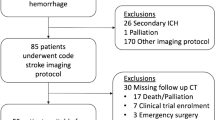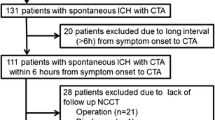Abstract
Objectives
To evaluate the association between dynamic progressive enhancing foci (“dynamic spot sign”) in acute haematoma on CT perfusion source images (CTP-SI) and haematoma expansion.
Methods
One hundred twelve consecutive patients with spontaneous intracerebral haemorrhage according to unenhanced CT, CTP and CT angiography within 6 h of symptom onset were prospectively evaluated. Patients were dichotomised according to the presence/absence of the dynamic spot sign on CTP-SI in haematoma. The predictive value of haematoma expansion was analysed.
Results
Haematoma expansion was detected in 28 patients (25.0 %) on follow-up unenhanced CT images. Thirty patients (26.8 %) demonstrated the dynamic spot sign on CTP-SI, about 83.3 % of patients with haematoma expansion (P < 0.001). Sensitivity, specificity, positive predictive value, negative predictive value and kappa value for expansion were 89.3 %, 94.0 %, 96.3 %, 83.3 % and 0.814, respectively. In multiple regression, the presence of the CTP dynamic spot sign within acute haematomas independently predicted haematoma expansion; the univariate analysis OR value was 131.667 (29.386–590.289), P < 0.0001. Moreover, the multivariate analysis CTP dynamic spot sign OR value was 203.996 (32.123–1295.488), P < 0.0001.
Conclusions
The CTP-SI dynamic spot sign is associated with acute haematoma expansion, is more direct in showing active ongoing bleeding and has a higher predictive value than the CTA spot sign.
Key Points
• It is important to identify potential progression of spontaneous intracerebral haemorrhage.
• Dynamic enhancement within CT perfusion source images is associated with haemorrhage expansion.
• The CTP dynamic spot sign may be present throughout arterial to venous phase imaging.
• The CTP dynamic spot sign carries a higher predive value for haematoma expansion than CTA.



Similar content being viewed by others
Abbreviations
- AHA:
-
American Heart Association
- APTT:
-
Activated partial thromboplastin time
- CTA-SI:
-
Computed tomography angiography source images
- CTP-SI:
-
Computed tomography perfusion source images
- ICH:
-
Intracerebral haemorrhage
- INR:
-
International normalised ratio
- SBP:
-
Systolic blood pressure
References
Broderick JP, Adams HP Jr, Barsan W et al (1999) Guidelines for the management of spontaneous intracerebral hemorrhage: a statement for healthcare professionals from a special writing group of the Stroke Council, American Heart Association. Stroke 30:905–915
Broderick JP, Brott T, Tomsick T et al (1992) The risk of subarachnoid and intracerebral hemorrhages in blacks as compared with whites. N Engl J Med 326:733–736
Broderick JP, Brott TG, Duldner JE et al (1993) Volume of intracerebral hemorrhage: a powerful and easy-to-use predictor of 30-day mortality. Stroke 24:987–993
Hemphill JC 3rd, Bonovich DC, Besmertis L, Manley GT, Johnston SC (2001) The ICH score: a simple, reliable grading scale for intracerebral hemorrhage. Stroke 32:891–897
Leira R, Davalos A, Silva Y et al (2004) Stroke Project, Cerebrovascular Diseases Group of the Spanish Neurological Society. Early neurologic deterioration in intracerebral hemorrhage: predictors and associated factors. Neurology 10:461–467
Davis SM, Broderick J, Hennerici M et al (2006) Recombinant activated factor VII intracerebral hemorrhage trial investigators. Hematoma growth is a determinant of mortality and poor outcome after intracerebral hemorrhage. Neurology 66:1175–1181
NINDS ICH Workshop Participants (2005) Priorities for clinical research in intracerebral hemorrhage: report from a National Institute of Neurological Disorders and Stroke workshop. Stroke 36:23–41.
Mayer SA, Rincon F (2006) Ultra-early hemostatic therapy for acute intracerebral hemorrhage. Semin Hematol 43:S70–S76
Mayer SA, Brun NC, Begtrup K et al (2005) Recombinant activated factor VII intracerebral hemorrhage trial investigators. Recombinant activated factor VII for acute intracerebral hemorrhage. N Engl J Med 352:777–785
Flibotte JJ, Hagan N, O’Donnell J et al (2004) Warfarin, hematoma expansion, and outcome of intracerebral hemorrhage. Neurology 63:1059–1064
Flaherty ML, Woo D, Haverbusch M et al (2005) Potential applicability of recombinant factor VIIa for intracerebral hemorrhage. Stroke 36:2660–2664
Yasui T, Kishi H, Komiyama M et al (1996) Very poor prognosis in cases with extravasation of the contrast medium during angiography. Surg Neurol 45:560–565
Murai Y, Ikeda Y, Teramoto A et al (1998) Magnetic resonance imaging documented extravasation as an indicator of acute hypertensive intracerebral hemorrhage. J Neurosurg 88:650–655
Walker MT, Wattamwar A, Mellman D et al (2005) Active hemorrhage into a postresection cavity detected by neuro-CT angiography. AJNR Am J Neuroradiol 26:1163–1165
Becker KJ, Baxter AB, Bybee HM et al (1999) Extravasation of radiographic contrast is an independent predictor of death in primary intracerebral. Stroke 30:2025–2032
Brouwers HB, Falcone GJ, McNamara KA et al (2012) CTA spot sign predicts hematoma expansion in patients with delayed presentation after intracerebral hemorrhage. Neurocrit Care 17:421–428
Romero JM, Heit JJ, Delgado Almandoz JE et al (2012) Spot sign score predicts rapid bleeding in spontaneous intracerebral hemorrhage. Emerg Radiol 19:195–202
Wada R, Aviv RI, Fox AJ et al (2007) CT angiography “spot sign” predicts hematoma expansion in acute intracerebral hemorrhage. Stroke 38:1257–1262
Demchuk AM, Dowlatshahi D, Rodriguez-Luna D et al (2012) Prediction of haematoma growth and outcome in patients with intracerebral haemorrhage using the CT-angiography spot sign (PREDICT): a prospective observational study. Lancet Neurol 11:307–314
d’Esterre CD, Chia TL, Jairath A et al (2011) Early rate of contrast extravasation in patients with intracerebral hemorrhage. AJNR Am J Neuroradiol 32:1879–1884
Kothari RU, Brott T, Broderick JP et al (1996) The ABCs of measuring intracerebral hemorrhage volumes. Stroke 27:1304–1305
Ohwaki K, Yano E, Nagashima H et al (2004) Blood pressure management in acute intracerebral hemorrhage: relationship between elevated blood pressure and hematoma enlargement. Stroke 35:1364–1367
Toyoda K, Okada Y, Minematsu K et al (2005) Antiplatelet therapy contributes to acute deterioration of intracerebral hemorrhage. Neurology 65:1000–1004
Fisher CM (1971) Pathological observations in hypertensive cerebral hemorrhage. J Neuropathol Exp Neurol 30:536–550
Huynh TJ, Keith J, Aviv RI (2012) Histopathological characteristics of the “spot sign” in spontaneous intracerebral hemorrhage. Arch Neurol 24:1–2
Ederies A, Demchuk A, Chia T et al (2009) Postcontrast CT extravasation is associated with hematoma expansion in CTA spot negative patients. Stroke 40:1672–1676
Almandoz JE, Yoo AJ, Stone MJ et al (2009) Systematic characterization of the computed tomography angiography spot sign in primary intracerebral hemorrhage identifies patients at highest risk for hematoma expansion: the spot sign score. Stroke 40:2994–3000
Kim J, Smith A, Hemphill JC et al (2008) Contrast extravasation on CT predicts mortality in primary intracerebral hemorrhage. AJNR Am J Neuroradiol 29:520–525
Hoh BL, Cheung AC, Rabinov JD et al (2004) Results of a prospective protocol of computed tomographic angiography in place of catheter angiography as the only diagnostic and pretreatment planning study for cerebral aneurysms by a combined neurovascular team. Neurosurgery 54:1329–1340
Sanelli PC, Mifsud MJ, Stieg PE (2004) Role of CT angiography in guiding management decisions of newly diagnosed and residual arteriovenous malformations. AJR Am J Roentgenol 183:1123–1126
Fainardi E, Borrelli M, Saletti A et al (2008) CT perfusion mapping of hemodynamic disturbances associated to acute spontaneous intracerebral hemorrhage. Neuroradiology 50:729–740
Mayer SA, Rincon F (2005) Treatment of intracerebral haemorrhage. Lancet Neurol 4:662–672
Xi G, Keep RF, Hoff JT (2006) Mechanisms of brain injury after intracerebral haemorrhage. Lancet Neuro 15:53–63
Acknowledgments
This work was supported by the National Key Project of Scientific and Technical Supporting Programmes funded by the Ministry of Science & Technology of China during the 11th 5-year plan (no. 2007BAI05B07).
Author information
Authors and Affiliations
Corresponding author
Rights and permissions
About this article
Cite this article
Sun, SJ., Gao, PY., Sui, BB. et al. “Dynamic spot sign” on CT perfusion source images predicts haematoma expansion in acute intracerebral haemorrhage. Eur Radiol 23, 1846–1854 (2013). https://doi.org/10.1007/s00330-013-2803-4
Received:
Revised:
Accepted:
Published:
Issue Date:
DOI: https://doi.org/10.1007/s00330-013-2803-4




